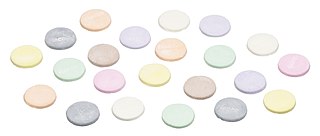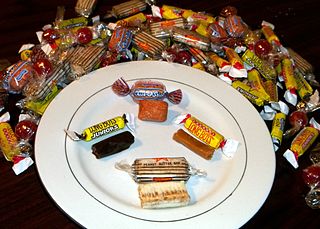
Necco Wafers are the namesake candy formerly made by the now-defunct New England Confectionery Company (Necco), which operated near Boston, Massachusetts. Necco Wafers were first produced in 1847 and were considered by the company to be its core product. Production of the candy went on hiatus in July 2018, and returned in May 2020.

Sweethearts are small heart-shaped sugar candies sold around Valentine's Day. Each heart is printed with a message such as "Be Mine", "Kiss Me", "Call Me", "Let's Get Busy", or "Miss You". Sweethearts were made by the New England Confectionery Company, or Necco, before being purchased by the Spangler Candy Company in 2018. They were also previously made by the Stark Candy Company. Necco manufactured nearly 8 billion Sweethearts per year. Similar products are available from Brach's and other companies. A similar type of candy is sold in the UK under the name Love Hearts.

Whoppers are malted milk balls covered with an artificially flavored "chocolatey coating" produced by The Hershey Company. The candy is a small, round ball about 3⁄4 inch (20 mm) in diameter. They are typically sold either in a small cardboard candy box, in a larger box that resembles a cardboard milk carton, the “Fun Size” variety which is a tube-shaped plastic package sealed at the sides, containing twelve Whoppers weighing 21 grams (0.75 oz), or the even smaller variety of a tube containing three Whoppers weighing 6.8 grams (0.23 oz).

Necco was an American manufacturer of candy created in 1901 as the New England Confectionery Company through the merger of several small confectionery companies located in the Greater Boston area, with ancestral companies dating back to the 1840s.

Sky Bar is an American candy bar introduced by Necco in 1938, discontinued in 2018, and reintroduced in 2019 by the Sky Bar Confectionary Company. Each Sky Bar has four sections, each with a different filling—caramel, vanilla, peanut, and fudge—all covered in milk chocolate.
The Clark Bar was introduced in 1917 by David L. Clark and was popular during and after both World Wars. It was manufactured in Pittsburgh, Pennsylvania, by the original family-owned business until 1955. It was then manufactured by corporate owners until a series of sales and bankruptcies in the 1990s resulted in transfer of production to the Revere, Massachusetts–based New England Confectionery Company (Necco). Following Necco's 2018 bankruptcy, the Clark Bar is now produced in western Pennsylvania, by the Altoona-based Boyer Candy Company. The Clark Bar is a candy bar consisting of a crispy peanut butter/spun taffy core and coated in milk chocolate. It was the first American "combination" candy bar to achieve nationwide success. Two similar candy bars followed the Clark Bar, the Butterfinger bar (1923) made by the Curtiss Candy Company and the 5th Avenue bar (1936) created by Luden's.

Boyer is a candy company located in Altoona, Pennsylvania. The factory is located in the downtown district.

Bit-O-Honey is an American candy product; it first appeared in 1924 and was made by the Schutter-Johnson Company of Chicago, Illinois. Bit-O-Honey was a new kind of candy bar consisting of six pieces wrapped in waxed paper and then packaged in a cover wrapper. The candy consists of almond bits embedded in a honey-flavored taffy, which makes for a long-chewing candy. Both a large bar and a small, bite-sized version are available for sale, the latter in bags of multiple units.

University Park at MIT is a mixed-use urban renewal project in Cambridge, Massachusetts, United States, occupying land near Central Square between the Massachusetts Institute of Technology (MIT) campus and the primarily residential neighborhood of Cambridgeport. It is a joint project of the City of Cambridge, MIT, and Brookfield Asset Management. It is not part of the MIT campus.

Candy Buttons, Candy Dots, or Pox are small rounded pegs of candy that are attached to a strip of paper. This classic sugar candy was originally introduced by the Cumberland Valley company and J Sudak and Son of Williamsburg, Brooklyn. In 1977, Sudak, which changed its name to Uncle Nibbles Candy Factory, sold to a repackager in Manhattan named CeeDee Candy, they sold to NECCO. After that acquisition, Necco bought the Cumberland Valley Company in 1980, which made them the exclusive manufacturer of this product in the United States. Each strip of the candy includes three flavors: cherry (pink), lime (blue), and lemon (yellow). Candy Buttons come in two strip sizes: long and short. The long is 22½ inches, while the short is 11¼ inches. NECCO made 750 million candy buttons in the course of a year. Following NECCO's 2018 bankruptcy, Candy Buttons were bought at auction by Cincinnati's Doscher's Candies. They were subsequently the first former Necco candy back to market.

Haviland Thin Mints are a chocolate-covered mint candy produced by Log House Foods of Plymouth, Minnesota. The candy is a mint fondant covered in dark chocolate, similar to the York Peppermint Pattie but smaller, thinner and shorter.

The D. L. Clark Company was founded in 1886 in Allegheny, Pennsylvania, now part of Pittsburgh, by David L. Clark (1864–1939), an Irish-born candy salesman. In 1921, Clark Brothers Chewing Gum Company was spun off as a separate corporation. In 1955, when the family-owned D. L. Clark company was sold to Beatrice Foods, they had production facilities in Pittsburgh and Evanston, Illinois. Beatrice sold it in 1983 to Leaf, and they in turn sold Clark in 1991, though Leaf retained the rights to Clark's Zagnut and P. C. Crunchers bars. The new owner, entrepreneur Michael P. Carlow, would operate it under the umbrella of the Pittsburgh Food & Beverage Company.

Mary Jane is an old-fashioned peanut butter- and molasses-flavored taffy-type candy. Originally made in 1914 by Robert O. Lord's candy manufacturing company, he named it after his wife. Lord sold his company to the Charles N. Miller Company in the Depression, then it was made by Stark Candy Company, it was later manufactured by Necco. Charles Miller initially made candy in his kitchen in what was once the home of Paul Revere It has featured the same "little girl" illustration on its wrappers since its inception.

The New England Confectionery Company Factory, also known as the NECCO Candy Factory, is an historic factory complex at 250 Massachusetts Avenue in Cambridge, Massachusetts. The property is now owned by DFS Advisors, and is under long-term lease to Novartis. The complex, which includes the factory building, a power plant, and a modern (2003) parking garage, occupies most of an entire city block bounded by Massachusetts Avenue, Cross Street, Albany Street, and Lansdowne Street. The Moderne-style building was constructed of reinforced concrete, faced predominantly with beige brick and trimmed with limestone. On some facades smooth concrete predominates as the finish surface. The building had a water tower that was painted to resemble a roll of Necco Wafers; during the alterations of the property for use by Novartis, the water tower was retained, and is now painted with a DNA pattern in pastel colors. The building was listed on the National Register of Historic Places in 2005.
The Spangler Candy Company is a privately owned international confectioner that has been manufacturing and marketing candy since 1906. Headquartered in Bryan, Ohio, Spangler's products include lollipops, candy canes, and marshmallow circus peanuts. Spangler brand names include Dum Dums, Saf-T-Pops, Whistle Pops, Spangler Candy Canes, and Spangler Circus Peanuts. Dum Dums were invented in 1924, and Spangler purchased the rights and equipment in 1953. The small multicolor lollipops are popular as free giveaways. In 2018, Spangler bought the defunct Necco, retaining the rights to Necco Wafers, Sweethearts conversation hearts, and Canada Mints.

The Atkinson Candy Company is a candy company based in Lufkin, Texas, best known for producing the Chick-O-Stick.
The Stark Candy Company, originally the Howard B. Stark Company, was a candy manufacturer founded in 1939, in Milwaukee, Wisconsin. It was a competitor to Necco and manufactured products including candy hearts, candy raisins, Mary Janes, peanut butter kisses, salt water taffy, and candy cigarettes.














